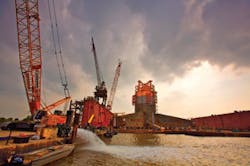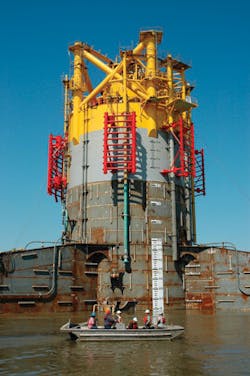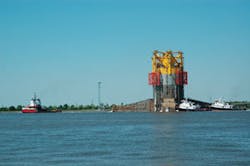BHP Billiton’s Neptune platform sails out to gulf
BHP Billiton Petroleum Inc. launched the hull for the Neptune tension-leg platform (TLP) on May 19, 2007. After a 5-day sail it reached location at Green Canyon Block 613.
J. Michael Yeager, BHP Billiton’s group president-energy, said “The Neptune sail away is an important milestone for BHP Billiton as it marks the beginning of installation for the company’s first operated standalone, deepwater production facility in the Gulf of Mexico.”
The Gulf of Mexico is on the verge of becoming a very significant producing area for the company. In addition to Neptune, BHP Billiton has the Genghis Khan, Atlantis (nonoperated) and Shenzi projects in development in the Atwater fold belt region of the deepwater Gulf of Mexico, Yeager noted.
In June 2005, the company and its partners sanctioned $850 million for development of Neptune. Despite the horrendous hurricane season experienced on the Gulf Coast later that year, the project remains on schedule for first production by yearend 2007, though costs are under review.
Neptune field consists of Atwater Blocks 573, 574, 575, 617, and 618, about 120 miles off Louisiana. Water depths range 4,200-6,500 ft, and the TLP production facility will be in about 4,250 ft, above the Sigsbee escarpment.
BHP Billiton is designated operator of the field with a 35% interest. Partners include Marathon Oil Co. (30%), Woodside Energy (USA) Inc. (20%), a subsidiary of Woodside Petroleum Ltd., and Maxus (US) Exploration (15%), a subsidiary of Repsol YPF.
The single-column Atlantia SeaStar TLP can process as much as 50,000 bo/d and 50 MMcfd of natural gas from wet-tree production wells.
“The field holds 100-150 MMboe recoverable reserves, and first oil is expected by yearend,” said Nigel Smith, BHP Billiton’s president of development for the petroleum group.
Construction
In 2005, BHP Billiton and its Neptune partners awarded an engineering, procurement, construction, and management (EPCM) contract to design and build a SeaStar TLP to Atlantia Offshore Ltd. (now SBM Atlantia). Atlantia received the contract after completing a frontend engineering and design study for a wet-tree TLP for the Neptune prospect. Atlantia is responsible for the complete TLP, including hull and topsides facilities and commissioning assistance.
Atlantia hired Signal International LLC to build the Neptune TLP hull.
Signal International Vice-Pres. Joe Roche told OGJ that this is the first TLP hull built by Signal; peak number of people on this project was about 500 (Fig. 1).
Signal ordered steel in June 2005 and began the hull fabrication work in fourth-quarter 2005 at its Orange, Tex. facility, which has 450,000 sq ft of covered area. The yard has been used extensively to construct offshore drilling and production units. In 2004, the drilling equipment module for a large Gulf of Mexico spar was built and assembled at Signal’s yards at Orange and Port Arthur, Tex.
The six TLP tendons were built by Gulf Marine Fabricators.
Atlantia’s Houston-based sister company, SBM-Imodco, designed the Neptune topside facilities, which are scheduled to be launched from Houma, La., by late June. Mating of the hull and topsides will be done about a week later.
The Neptune TLP will join four existing SeaStar TLPs in the Gulf of Mexico. Of the previous four, three accommodate wet-tree production and one supports dry trees.
Installation
The Neptune TLP was floated off Signal International’s World War II-vintage mobile dry dock in Port Arthur a few days before the sail away at a 14½-ft draft (Fig. 2).
The winds and weather were favorable on May 19, blowing about 5 mph. “Perfect towing conditions,” said a representative from Otto Candies LLC. No cold fronts were forecast and it was too early for tropical storms.
One main tug, the Kelly Candies, and two assist tugs took the TLP from the dock, through the channel to the Sabine Pass sea buoy on the first day at 2 knots/hr on a flood tide (Fig. 3). Once in open water, the tug could pull at 3½ knots for another 4 days travel to location in Green Canyon.
Heerema Marine Contractor’s largest deepwater construction vessel (DCV) Thialf had preinstalled the piles and was installing the tendons at the time the hull left the dock.
After the hull installation commences, it will take about 5 days to position the tendons, ballast, lock off on the tendons, and pump water to create top tension.
Heerema’s DCV Balder will pick up and hang the steel catenary risers for gas and oil export and two field flow lines; the Thialf will use its dual cranes to mate the topsides and hull.
Neptune production will flow to the Mardi Gras pipeline system. Enbridge owns and operates the 26-27 miles of lateral lines, laid by Allseas in January-February 2007. The jumpers will be installed June-August, BHP Billiton’s Smith told OGJ. Neptune’s oil will flow to the Caesar trunkline and gas to the Cleopatra trunkline.
TLPs
Neptune is the 23rd TLP worldwide, according to Mustang Engineering. It joins 14 TLPs already installed in the Gulf of Mexico.
There are three TLPs in the North Sea: two off Norway, and one decommissioned off the UK. Four TLPs have been installed off Africa: Kizomba A and B off Angola, and Okume E (Oveng) and Okume F off Equatorial Guinea. The West Seno A TLP was installed in the Makassar Strait, off eastern Java.
Conoco installed the world’s first TLP in the UK North Sea’s Hutton field in July 1984, a six-column conventional semisubmersible design that could process 120,000 bo/d and 10 MMcfd in 482 ft water depth (now retired; OGJ, Nov. 5, 2001). Five years later, in July 1989, Conoco installed the world’s second TLP at the Jolliet field in the Gulf of Mexico. The Jolliet TLP has a four-column hull, the most common TLP hull design (17 of 23).
Most TLPs have steel hulls, 12 or 16 tendons attached to the four hull columns, and dry trees. The Heidrun TLP, installed in the Norwegian North Sea in June 1995, is the first and so far only, concrete hull.
Twenty years after Hutton, in August 2004, Conoco set a depth record, installing an extended-leg TLP in the Gulf of Mexico’s Magnolia field in 4,674 ft water depth (OGJ, Nov 22, 2004, p. 50).
The single-column monohull design (Atlantia SeaStar) was adopted by Eni in August 1998, when it installed the first of the five SeaStars over the Morpeth field, in the Gulf of Mexico. The SeaStar TLP design has six tendons arranged in a 3x2 pattern; production is from wet-tree wells.
The other SeaStar TLPs are Eni’s Allegheny (installed August 1999), Chevron’s Typhoon (June 2001), Total E&P USA’s Matterhorn (July 2003), and now Neptune (June 2007).
BHP Billiton’s Dennis McLaughlin, project director for Neptune, told OGJ that the Neptune team set the robust design criteria for the TLP in 2004, following Hurricane Ivan, and they met all ABS, Coast Guard, and US Minerals Management Service code standards. “The industry is constantly adjusting criteria as it learns,” he said.
Then the Typhoon SeaStar TLP was heavily damaged during Hurricane Rita in 2005.
McLaughlin said that BHP Billiton, a 50% partner with operator ChevronTexaco, participated in all forensic activities related to that incident.
The Neptune team used independent third-party checks of all engineering and design processes, as well as comprehensive model testing at a wave tank in the Netherlands. McLaughlin told OGJ that Neptune’s design is considerably different from preceding installations of the SeaStar TLP. It will be the first deepwater facility that reflects lessons learned from the 2004-05 hurricane seasons.
Neptune field development
The field was discovered in 1995-the first discovery in the western Atwater foldbelt. The Neptune-2 appraisal well was drilled in 1997. BHP Billiton took over as operator in 2002 and drilled four appraisal wells and two sidetracks, including:
- Neptune-3, 2002, 120 ft net pay.
- Neptune-5, 2003, 500 ft net pay.
- Neptune-7, 2004, 114 ft net pay.
In 2004, BHP Billiton signed a 2-year contract to drill in the Gulf of Mexico with the GlobalSantaFe Development Driller 1 semisubmersible. In April 2006, the company extended the contract 4 more years, to 2010. The DD1 began drilling the seven production wells in June 2006. All topholes were predrilled.
Well completion procedures will be similar to those used at Atlantis, said Smith, including frac packs. “And we’re learning a lot from our nonoperated interests,” he said.
BHP Billiton plans subsea completions for the seven Neptune wells at four drill centers in the currently sanctioned southern part of the Neptune field. Two of the drill centers have single wells, another has two wells, and the fourth has three wells and a manifold. The company planned for additional drill centers along the north flow line, installing three inline sleds.
The 8-in. nominal diameter flowlines are insulated with 4-in.-thick GSPU (glass syntactic polyurethane) but are not heated. They were installed by Technip.
Cameron and Aker Kvaerner are the main subsea suppliers on the Neptune project.
After Neptune, the DD1 may undertake drilling at the nearby Shenzi field, Smith told OGJ.
“We have a tremendous amount of activity in the deepwater Gulf of Mexico at this time,” said Yeager. “Also, with operated projects in Western Australia, Pakistan, and Trinidad continuing to progress, we are about to significantly change BHP Billiton Petroleum.”
Neptune SeaStar tension-leg platform
Payload (deck, facilities, risers) 8,000 tons
Displacement 27,000 tons
Tendons Six, 36-in. diameter
Main column dimensions 76-ft diameter x 128-ft height
Pontoon dimensions 176-ft radius x 48-ft height
Draft 98 ft
Deck dimensions 120 x 110 ft, three levels
Main Contractors:
SBM Atlantia, Houston Hull, topsides - design and supply
Signal International LLC, Orange, Tex. Hull fabrication
Gulf Island Fabrication, Houma, La. Topsides fabrications
Gulf Marine Fabricators, Ingleside, Tex. Tendon and pile fabrication
Heerema Marine Contractors, Houston Offshore installation



